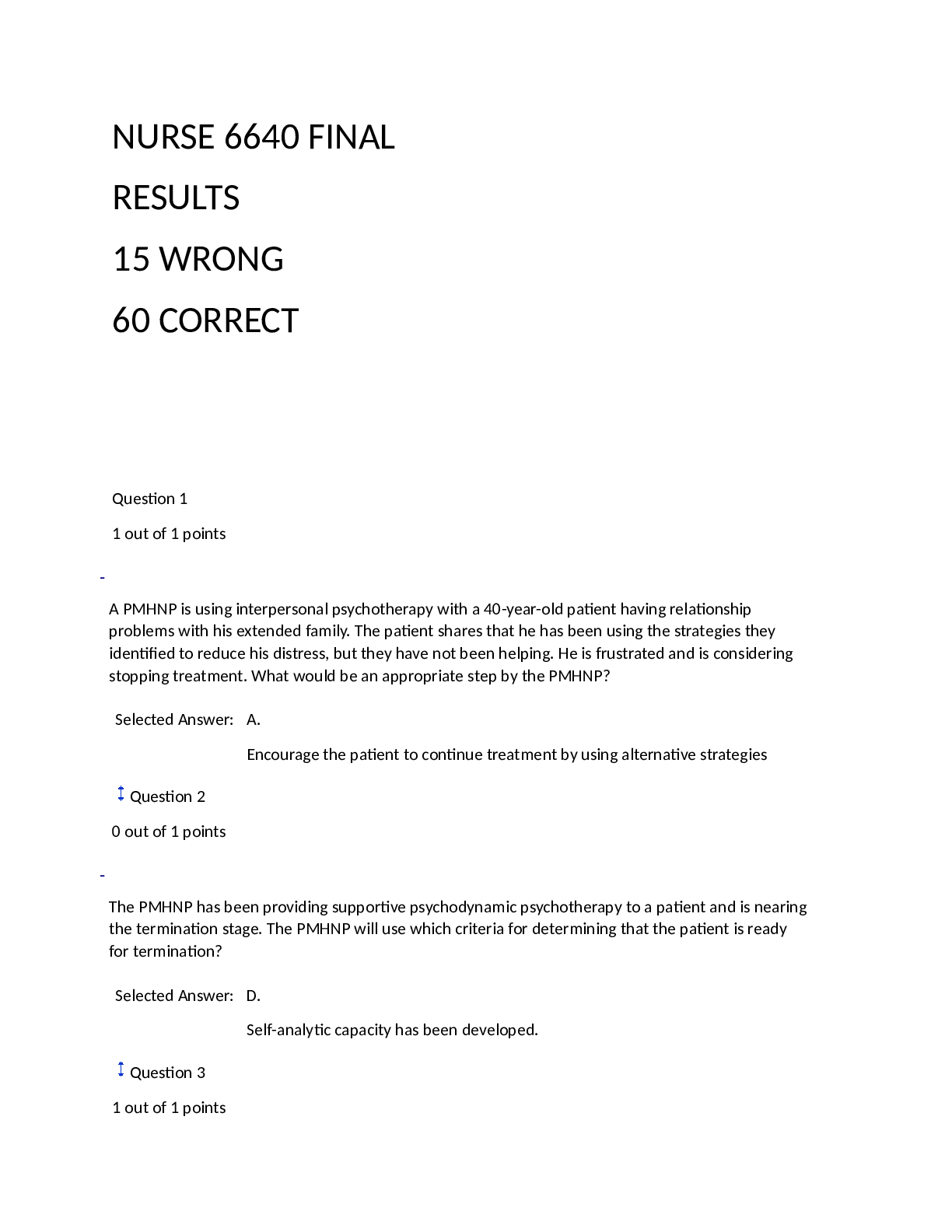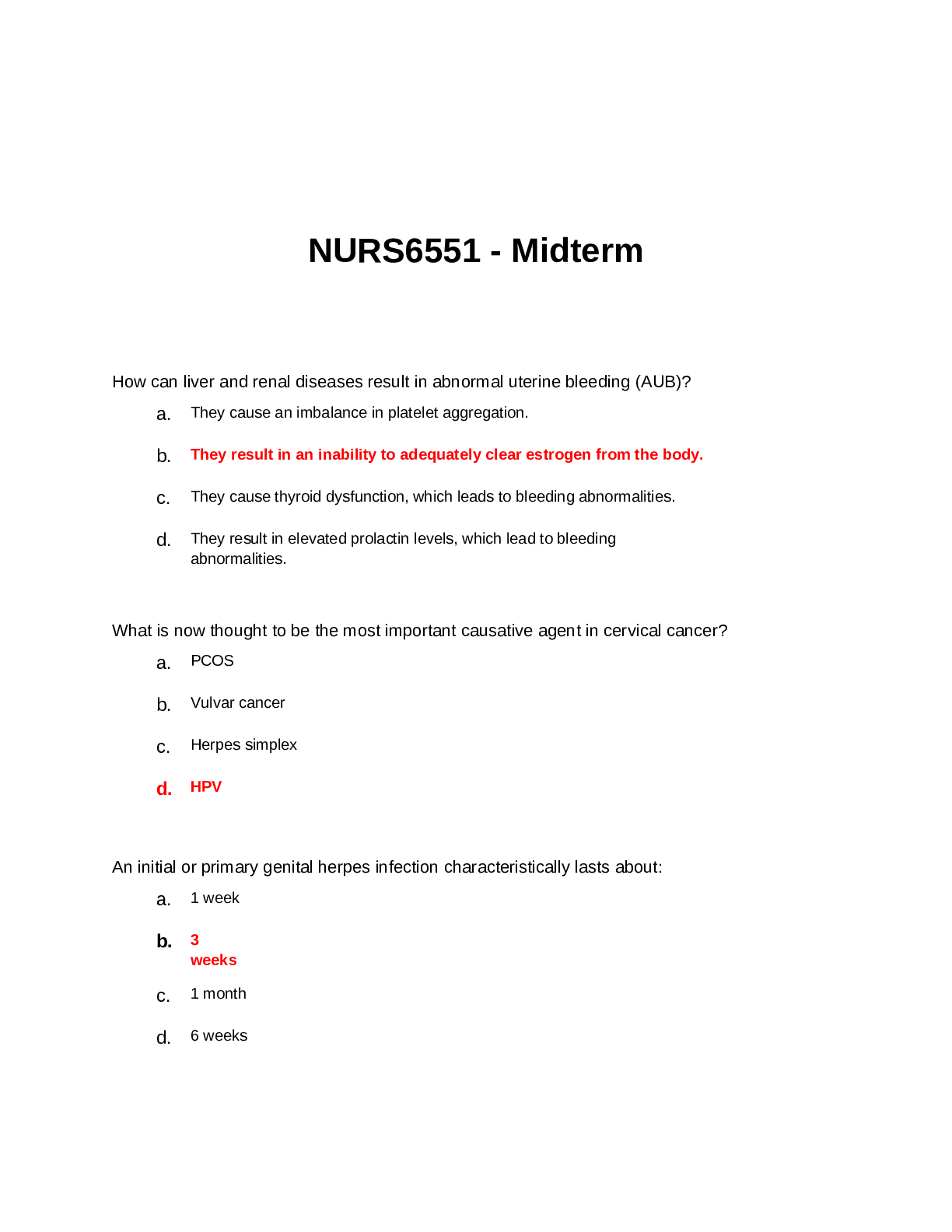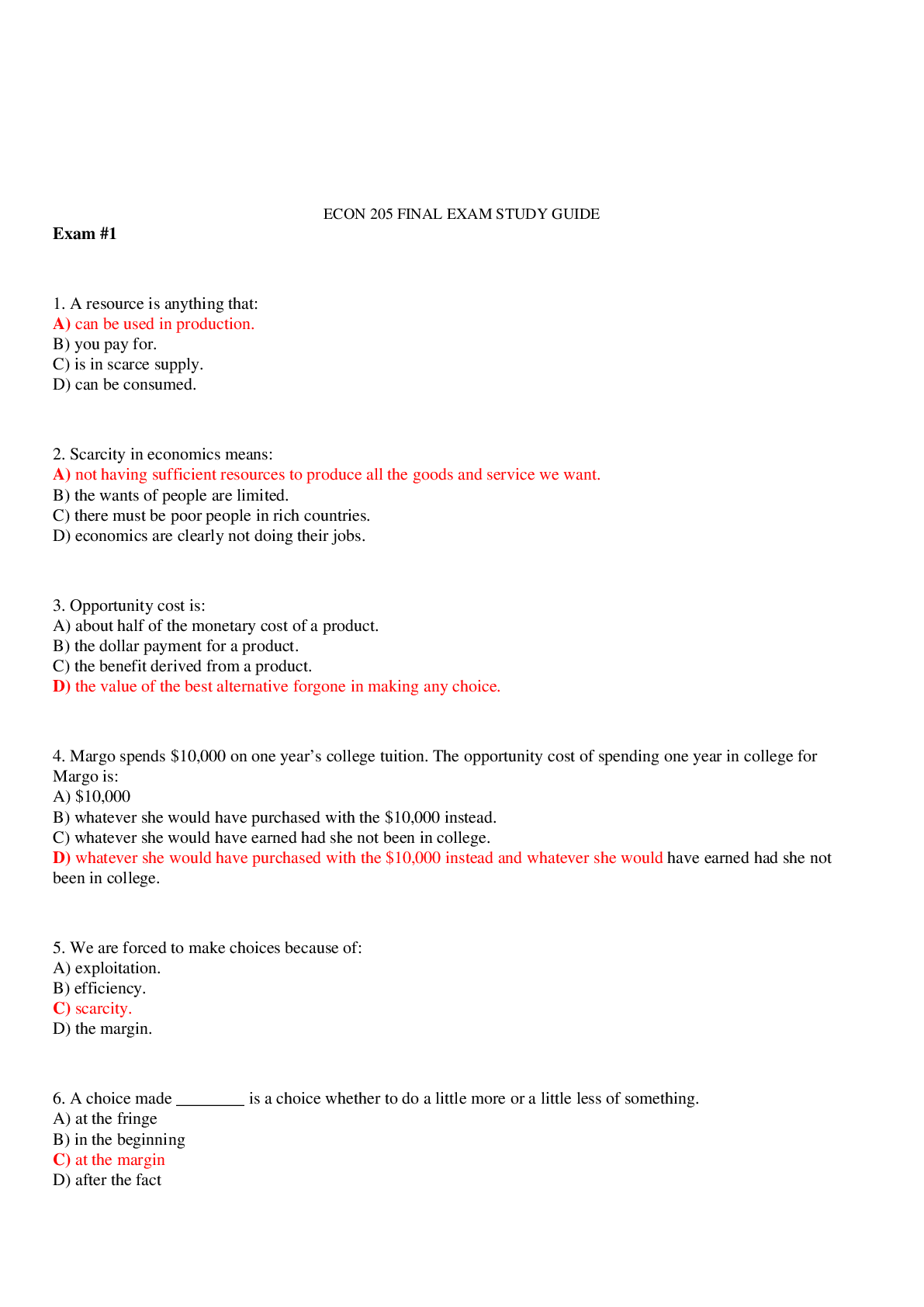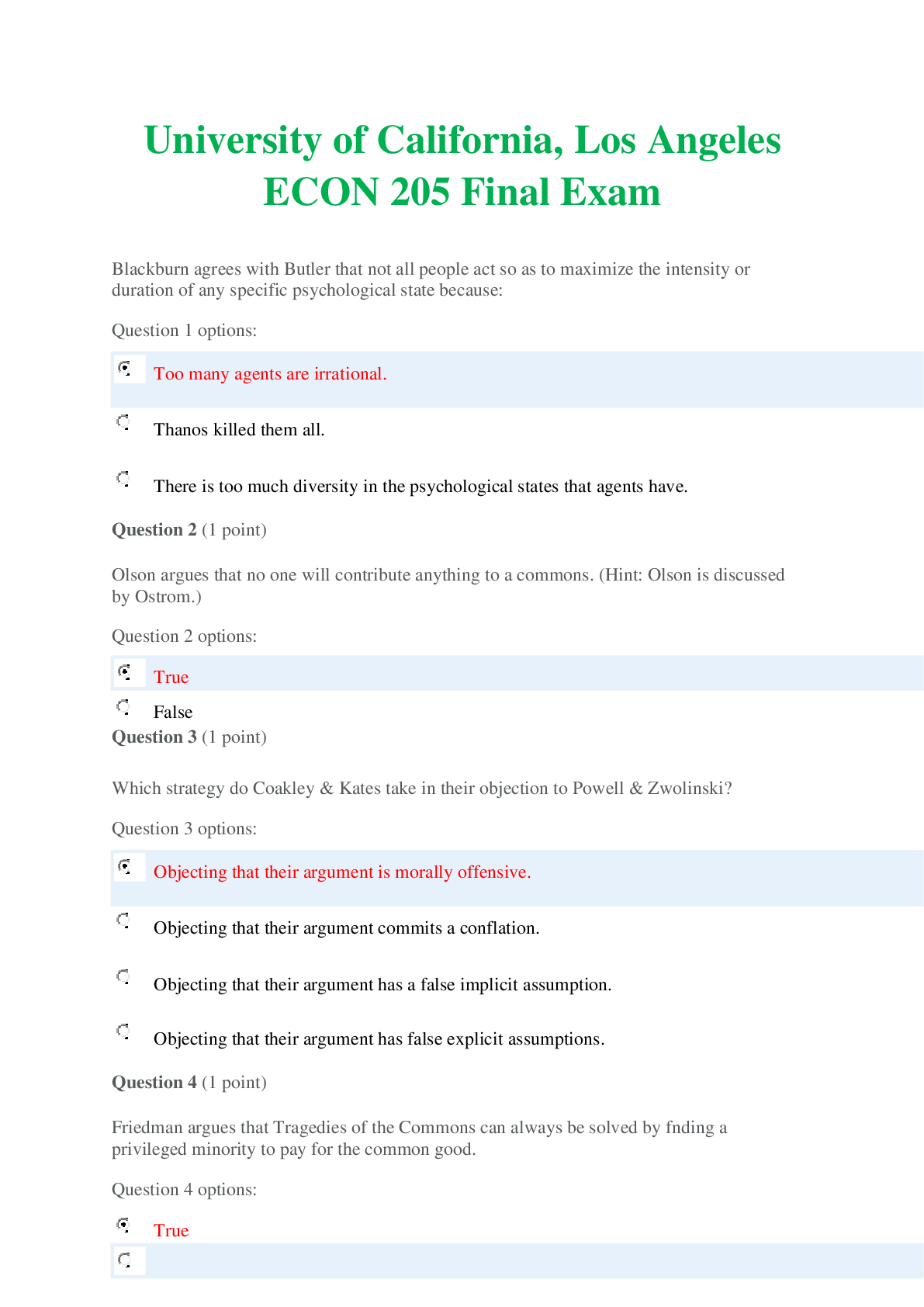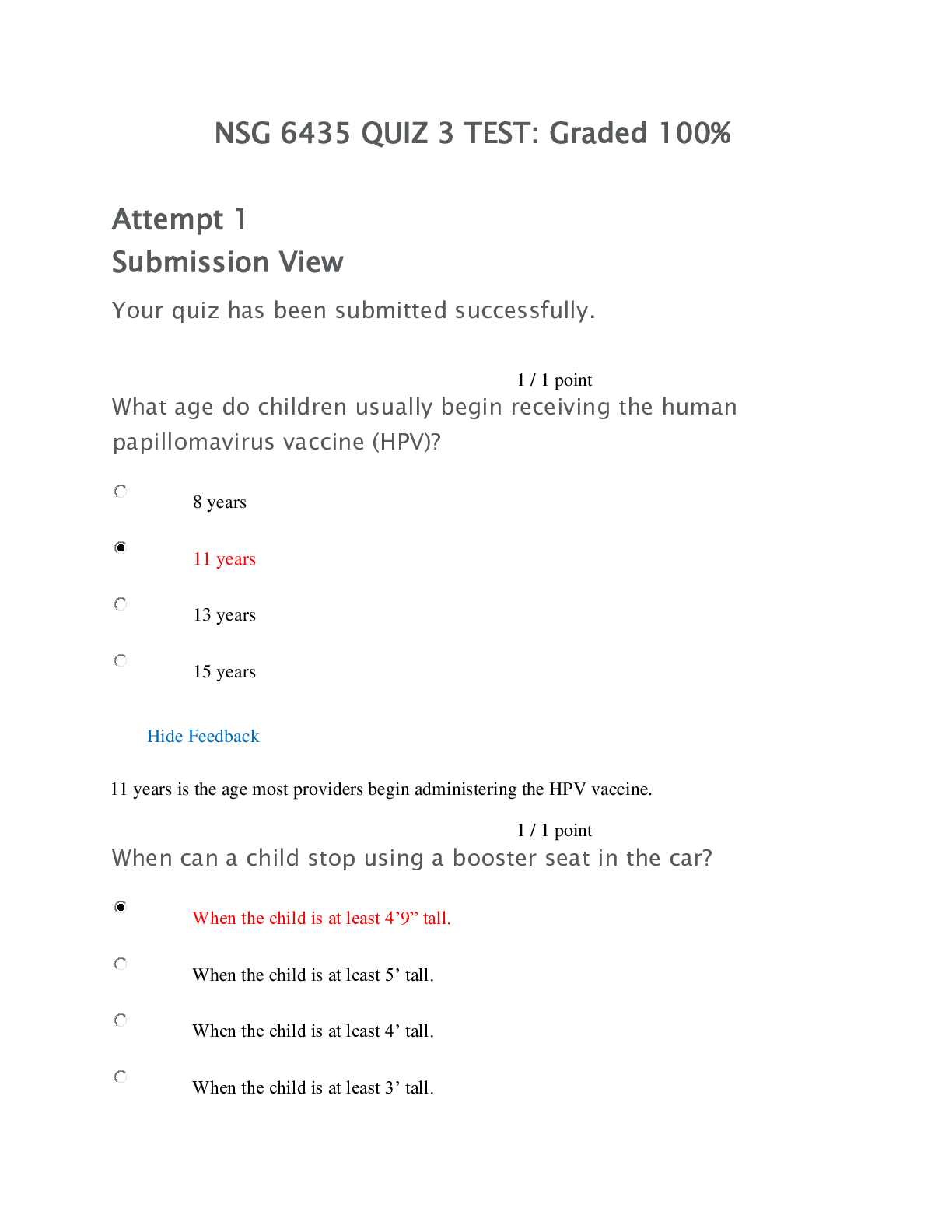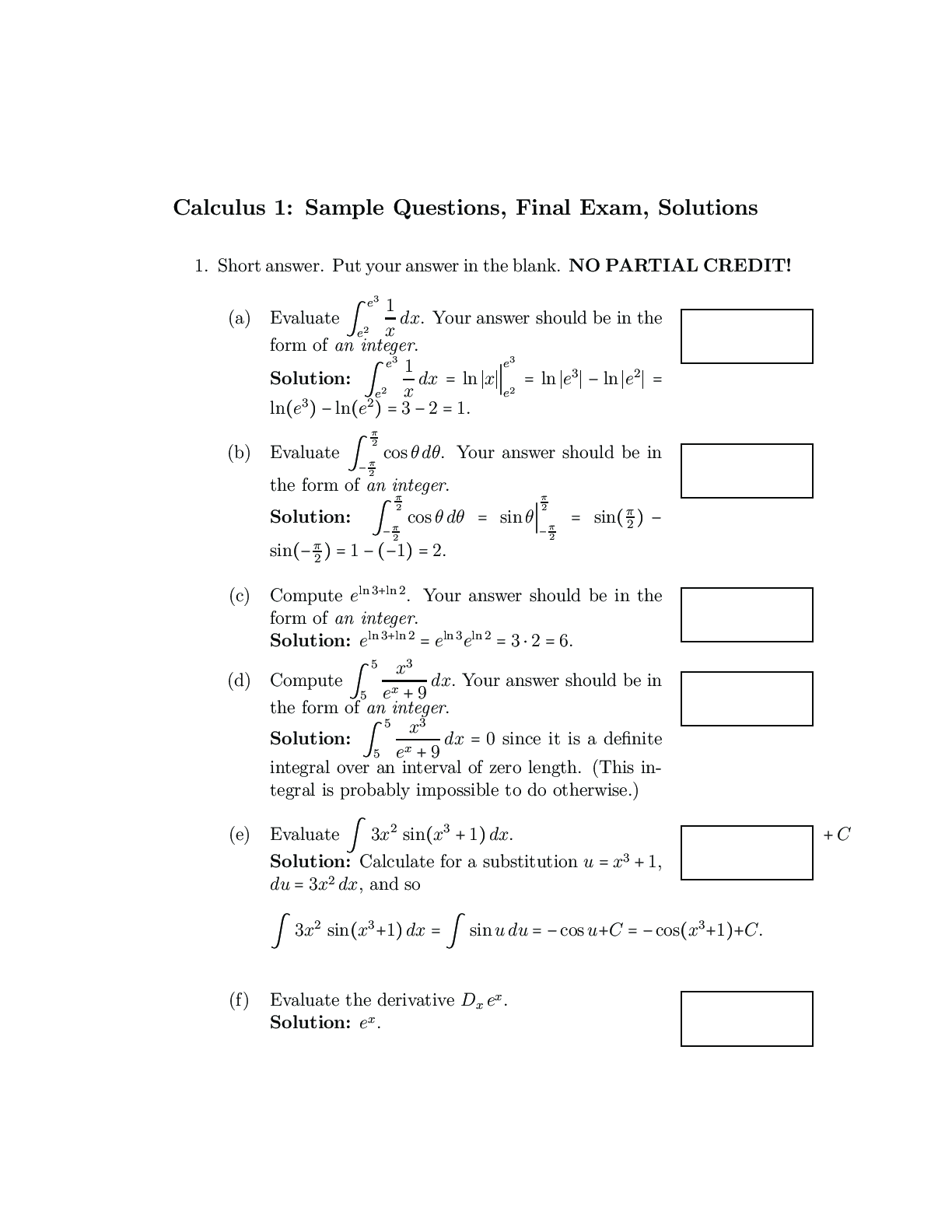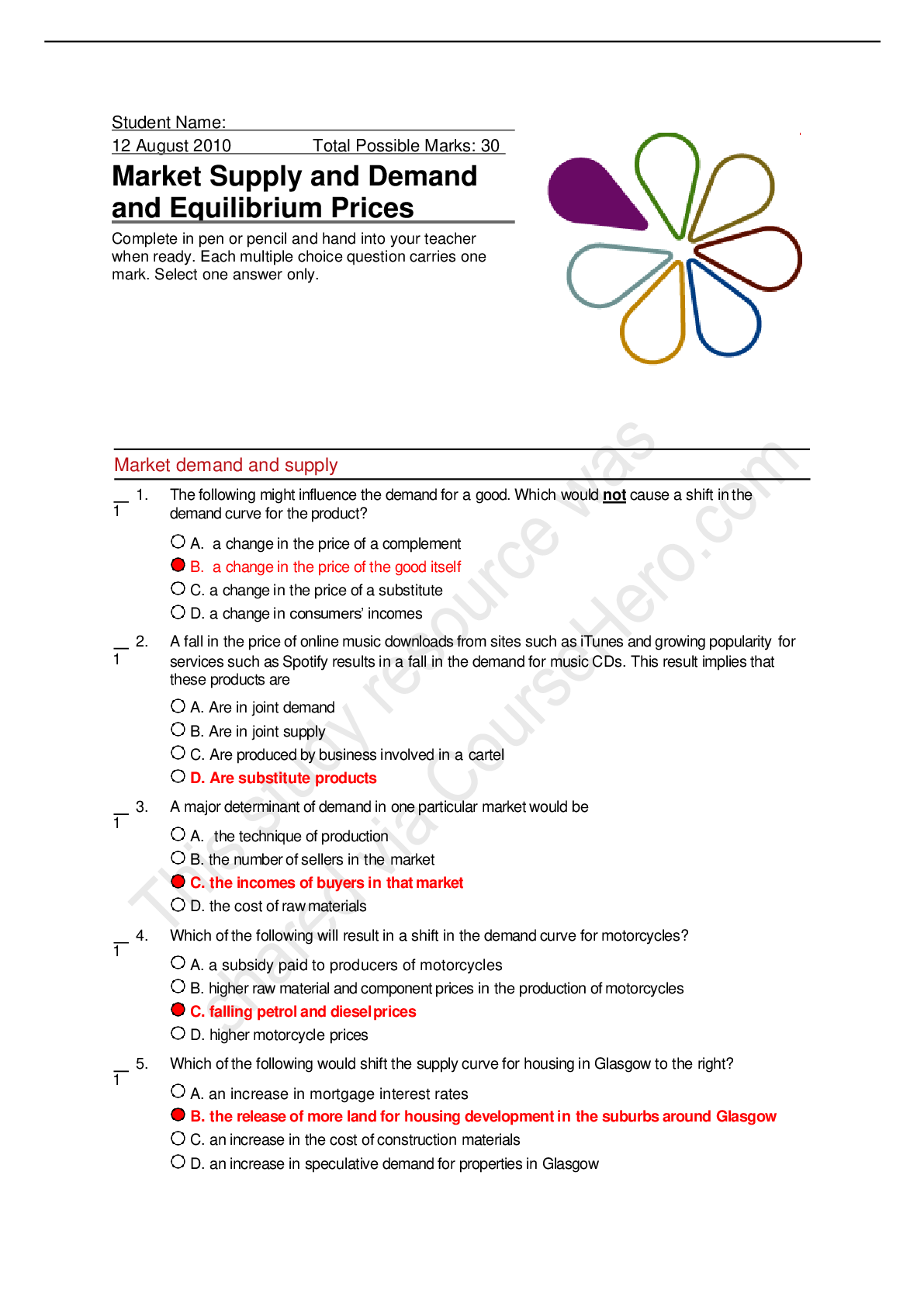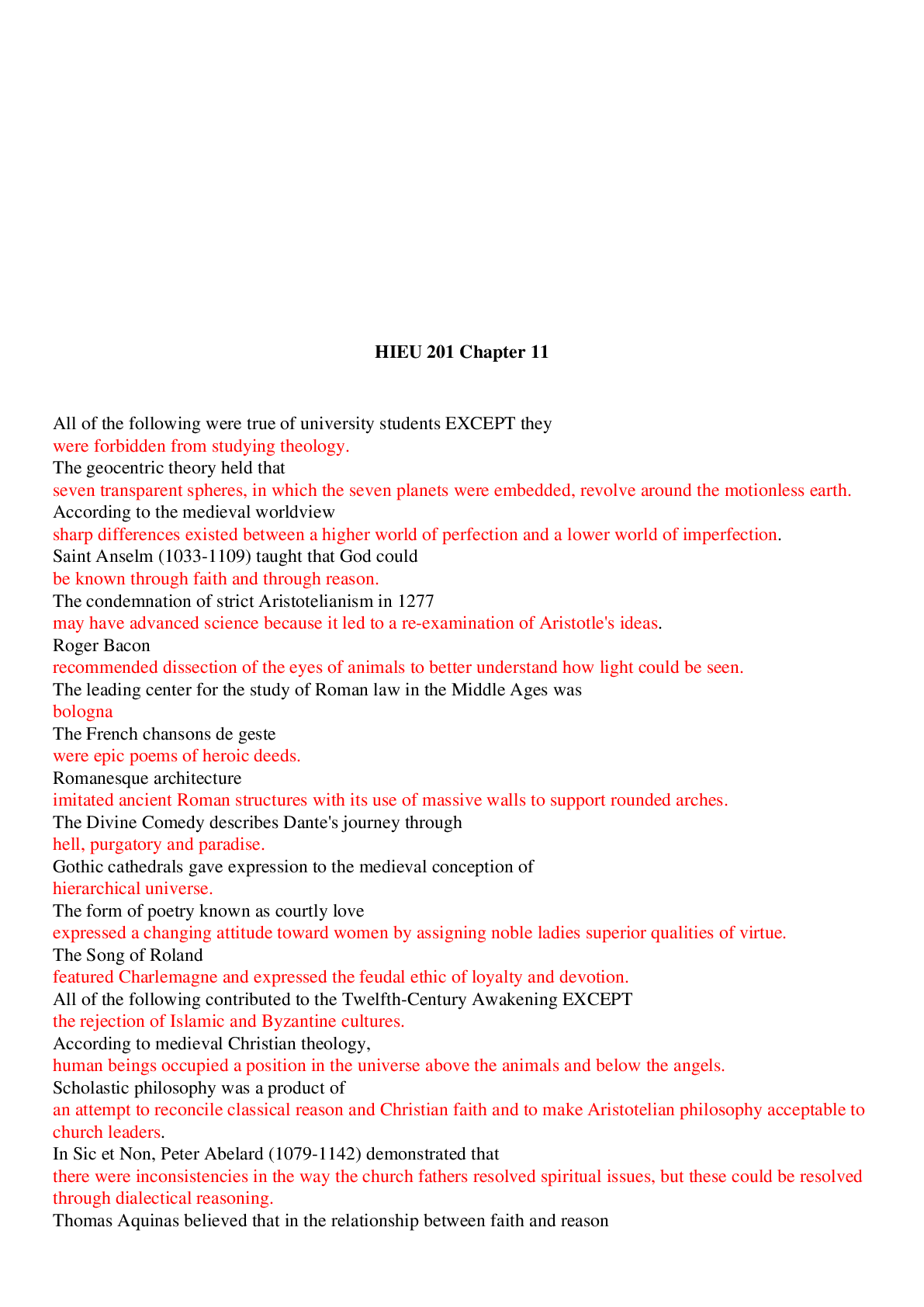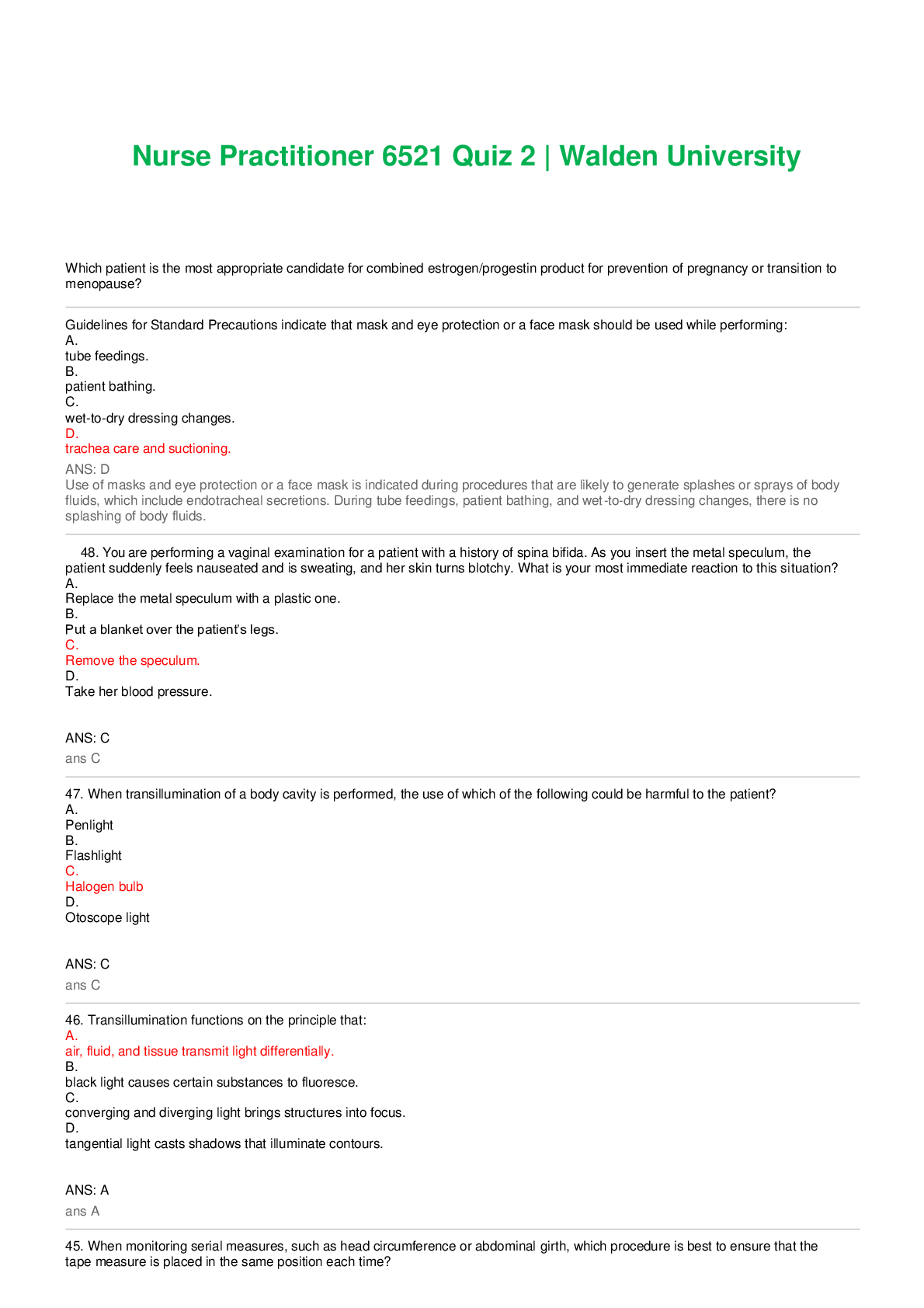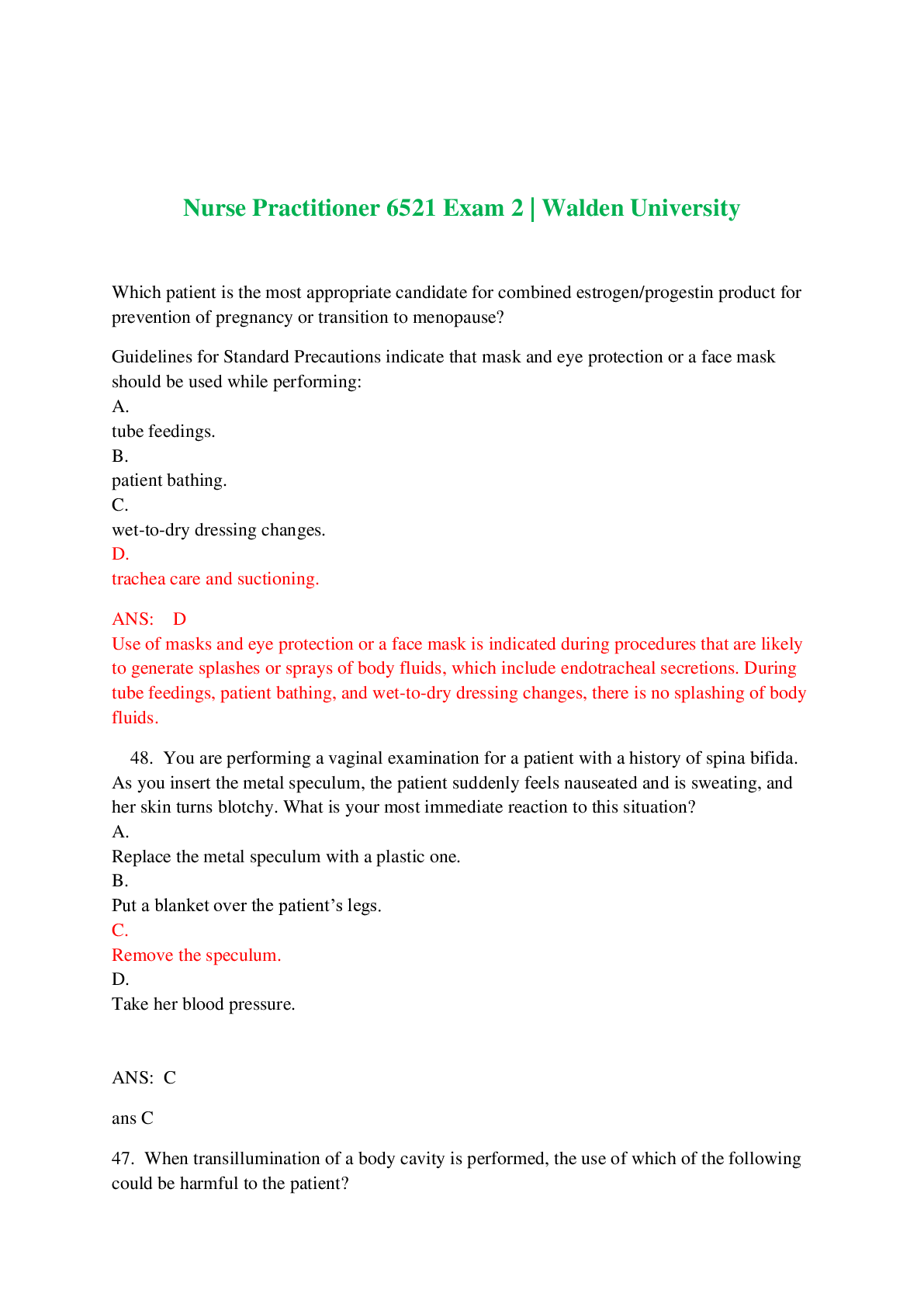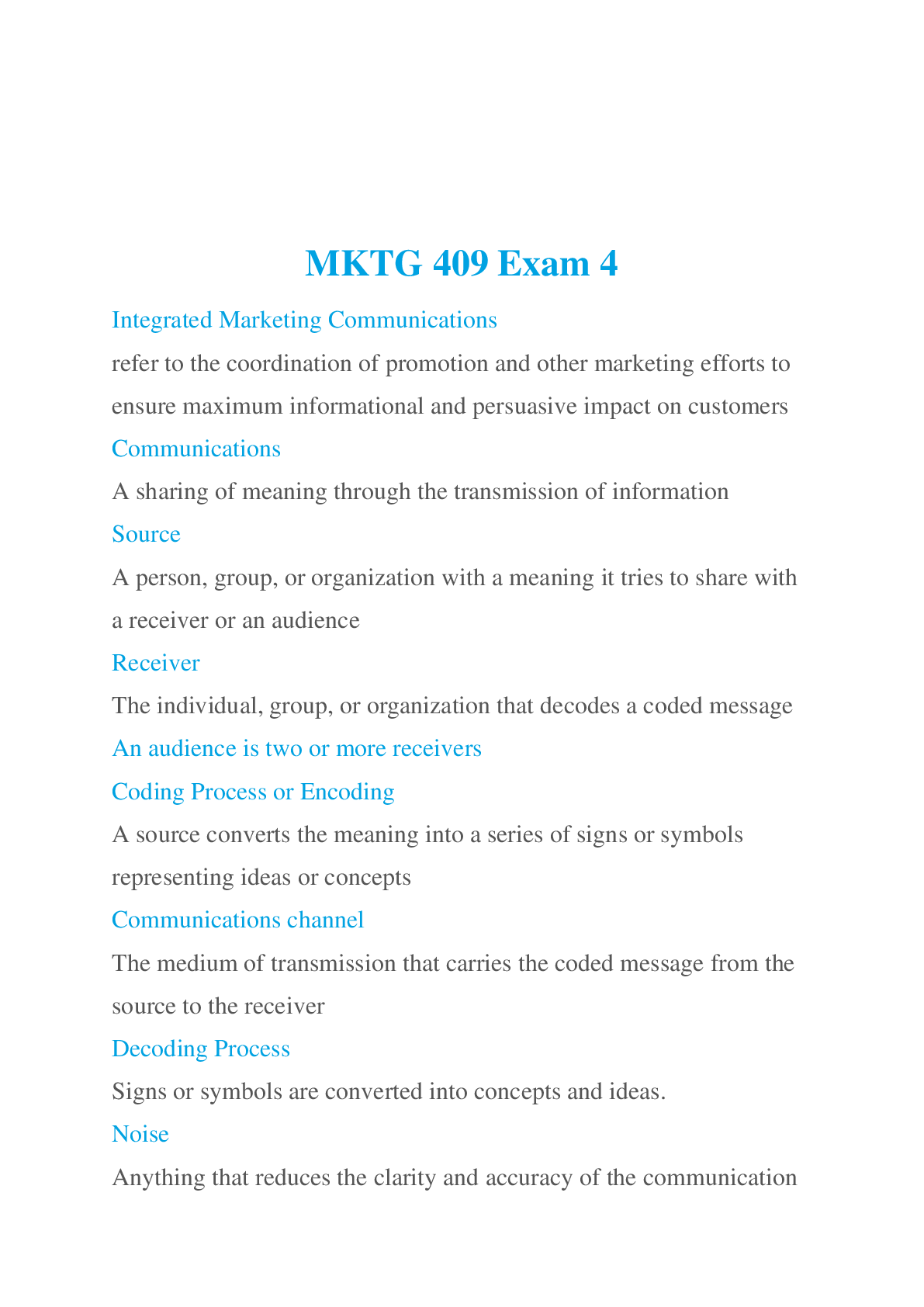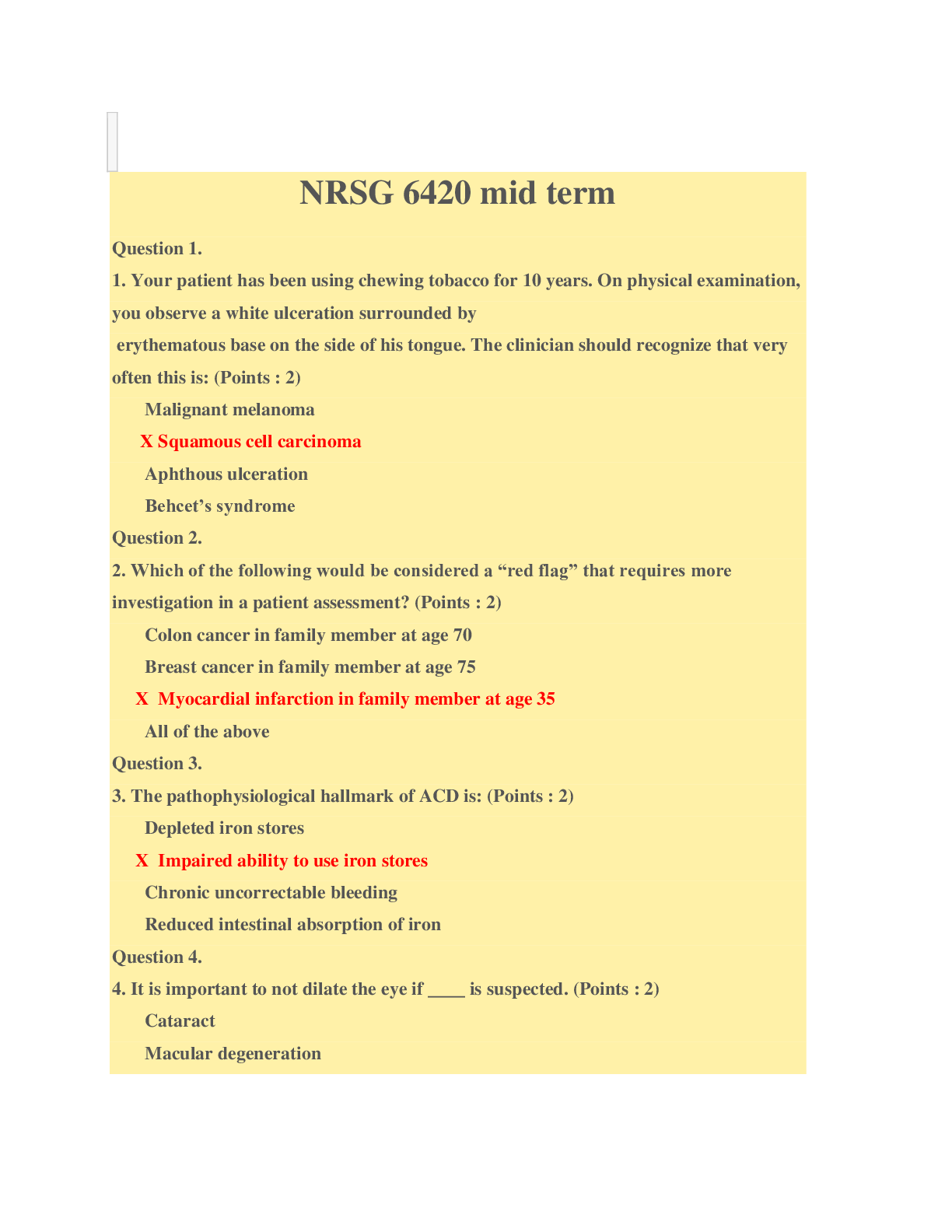MED SURGE Respiratory ATI
Document Content and Description Below
MED SURGE Respiratory ATI 1- A charge nurse receives notification of the admission of a client who is coughing frequently and whose sputum is pink, frothy, and copious. The client has history of nigh... t sweats, anorexia, and weight loss. Which of the following actions should the nurse take? (SATA) -Assign the client to a private room with negative-pressure airflow -Wear an N95 respirator when entering the client’s room. 2- A nurse is assisting a provider with a comprehensive physical examination of a client. When the provider uses transillumination, the nurse should explain to the client that this technique help evaluate which of the following structures? -Maxillary sinuses 3- A nurse is caring for a client who smokes cigarettes and has a new diagnosis of emphysema. How should the nurse assist the client with smoking cessation? -Discuss ways the client can reduce the number of cigarettes smoked per day. 4- A nurse is planning care for a client who has chronic obstructive pulmonary disease (COPD) and is malnourished. Which of the following recommendations to promote nutritional intake should the nurse include in the plan? -Eat high-calorie food first. Rational: client who has COPD experience early satiety. Client should eat calorie-dense food first. 5- A nurse is preparing to administer cisplatin IV to a client who has lung cancer. The nurse should identify that which of the following findings is an adverse effect of this medication? -Tinnitus. Rational: An adverse effect of cisplatin is ototoxicity, which can cause tinnitus. 6- A nurse in a medical-surgical unit is assessing a client. The nurse should identify that which of the following findings is a manifestation of a pulmonary embolism? -Stabbing chest pain Rational: sudden chest pain that is sharp and stabbing is a manifestation of pulmonary embolism. Other manifestations include dyspnea, coughing, hemoptysis (coughing up blood), tachypnea, tachycardia, diaphoresis, and feeling of impending doom. 7- A nurse in the PACU is assessing a newly admitted client and observes intercostal retractions and a high-pitched inspiratory sound (stridor). The nurse should identify theses findings as manifestations of which of the following complications? -Respiratory obstruction 8- A nurse is reviewing the laboratory results of a client who has metabolic alkalosis. Which of the following laboratory values should the nurse expect? -ph 7.49,HCO3-32mEq/L, PaCO2 40mmHg Rational: Metabolic alkalosis: pH and bicarbonate values are greater than the expected references range, and the PaCO2 is within the expected reference range. 9- A nurse is providing teaching to a client who has a chronic cough and is scheduled for a bronchoscopy. Which of the following client statements indicates an understanding of the teaching? -“A tissue sample might be obtained during the procedure” 10- A nurse is preparing a client for a bronchoscopy. Which of the following actions should the nurse take? (SATA) -Explain that the client will receive sedation and will not remember the procedure. -Verify that the client understands the purpose and nature of the procedure. 11- A nurse is preparing a client for discharge following a bronchoscopy. Which of the following assessment is the nurse’s monitoring priority? -Confirming the gag reflex Rational: The greater risk to the client’s safety is aspiration resulting from a depressed gag reflex. 12- A nurse is caring for a client who is postoperative following a thoracic lobectomy. The client has 2 chest tubes in place: 1 in the lower portion of the thorax and the other higher on the chest wall. When a family member asks why the client has 2 chest tubes, which of the following responses should the nurse make? -“The lower tube will drain blood, and the higher tube will remove air.” 13- A nurse is providing teaching to a client who will undergo a total laryngectomy. Which of the following statements indicate that the client understands the impact of the surgery? - “I understands that I will have a permanent tracheostomy after the surgery.” Rational: With a partial laryngectomy, the tracheostomy is temporary. With the total laryngectomy the tracheostomy will be permanent. 14- A nurse is providing discharge instructions to a client who has a new laryngectomy. The nurse tells the client to be careful while bathing to prevent which of the following complications? -Aspiration of water. Rational: This is a client with a tracheostomy, so he will need to use a shower shield over the stoma when bathing or showering to keep water out of the airway. 15- A nurse is caring for a client who is extremely anxious and is hyperventilating. The client’s ABG results are pH 7.50, PaCO2 27 mmHg, and HCO3-25 mEq/L. The nurse should identify that the client has which of the following acid-base imbalances? -Respiratory alkalosis. 16- A nurse is planning postoperative education for a client who will undergo a radical neck dissection for cancer of the larynx. The nurse should include which of the following topics? (SATA) -NPO status -Alternative methods of communication - Changes in body image -Swallowing exercises. 17- A nurse in a clinic is providing teaching for a client who is scheduled to have a tuberculin skin test. Which of the following pieces of information should the nurse include? - “You must return to the clinic to have the test read in 2 or 3 days.” 18- A nurse is providing discharge teaching to a client who is postoperative following a rhinoplasty/ Which of the following instructions should the nurse include? “Lie on your back with your head elevated 30º when resting.” 19- A nurse is preparing to assist provider with an arterial blood withdrawal from a client’s radial artery for ABG measurements. Which of the following actions the nurse plan to take? -Perform an Allen’s test prior to obtaining the specimen. Rational: the nurse should ensure that the circulation of the hands is adequate from the ulnar artery in case the radial artery is injured from the blood draw. The most common site for withdrawal of arterial blood gases is the radial artery. 20- A nurse is providing teaching to a client about pulmonary function testing. Which of the following tests measures the volume of air the lungs can holds at the end of maximum inhalation? -Total lung capacity 21- A nurse is providing preoperative teaching to a client who is to undergo a pneumonectomy. The client states, “I am afraid coughing will hurt after surgery.” Which of the following statements by the nurse is appropriate? -“I will show you how to splint your incision while coughing.” 22- A nurse is caring for a client who has a tracheostomy and is receiving mechanical ventilation. When the low-pressure alarm on the ventilator sounds, it indicates which of the following to the nurse? -A leak within the ventilator’s circuitry. 23- A nurse is caring for a client who is postoperative following a rhinoplasty. Which of the following findings should the nurse report to the surgeon? -Frequent swallowing Rational: this indicates posterior nasal bleeding and possibly hemorrhage. 24- A nurse is caring for a client immediately following extubation. Which of the following manifestations indicates that the nurse should call the rapid response team? -Stridor Rational: the nurse should identify that stridor (high-pitched crowing sound heard during inspiration) is caused by laryngeal edema and can indicate impending airway obstruction. 25- A nurse is caring for a client who has a chest tube. The nurse notes that the chest tube has become disconnected from the chest drainage system. Which of the following actions should the nurse take? -Immerse the end of the chest tube in a bottle of sterile water. 26- A nurse is caring for a client following a right pleural thoracentesis. The nurse measures a total of 35 ml of purulent drainage. Which of the following findings should the nurse recognize as an indication of tension pneumothorax? (SATA) -Tracheal deviation to the left -Absent breath sounds on the right side -Neck vein distention 27- A nurse is providing discharge teaching to a client who has emphysema. Which of the following instructions should the nurse include? -“Try to drink at least 2 to 3 liters of fluid per day” Rational: clients who have emphysema should drink 2 to 3 L per day to help liquefy secretions. 28- A nurse is caring for a client who had a left lower lobectomy to treat lung cancer. Which of the following factors will have a significant impact on the plan of care for this client? -Lung cancer usually has metastasized before the client present with symptoms. 29- A nurse is assessing a client who has a positive tuberculin skin test. Which of the following findings indicates that the client has active tuberculosis? -Night sweats. Rational: manifestations of active tuberculosis include a fever, coughing, night sweats, anorexia, and fatigue. 30- A nurse is providing discharge teaching to a client who had a pulmonary embolism. Which of the following statements indicates that the client understands the information? -“I’ll call the doctor if I see any blood in my urine or stool.” Rational: bleeding precautions are essential to clients who had a pulmonary embolism because they taken an anticoagulant. They should report any signs of bleeding immediately. 31- A nurse is caring for a client whom the respiratory therapist has just removed the endotracheal tube. Which of the following actions should the nurse take first? -Evaluate the client for stridor 32- A nurse in a provider’s office is assessing a client who states he was recently exposed to tuberculosis. Which of the following findings is a clinical manifestation of pulmonary tuberculosis? -Night sweats 33- A nurse on a medical-surgical unit is caring for a client who is postoperative following a hip replacement surgery. The client reports feeling apprehensive and restless. Which of the following findings should the nurse recognize as an indication of pulmonary embolism? -Sudden onset of dyspnea. Rational: clinical manifestations of pulmonary embolism have a rapid onset. Dyspnea occurs duet o reduced blood flow to the lungs. 34- A client is admitted to the emergency department following a motorcycle crash. The nurse notes a crackling sensation upon palpation of the right side of the client’s chest. After notifying the provider, the nurse document this finding as which of the following? -Crepitus Rational: crepitus also called subcutaneous emphysema, is a coarse crackling sensation that the nurse can feel when palpating the skin surface over the client’s chest. Crepitus indicates an air leak into the subcutaneous tissue, which is often a clinical manifestation of pneumothorax. 35- A nurse on a medical unit is caring for a client who aspirated gastric contents prior to admission. The nurse administers 100% oxygen by nonrebreather mask after the client reports severe dyspnea. Which of the following findings is a clinical manifestation of acute respiratory distress syndrome (ARDS)? -PaO2 50 mmHg Rational: client who has manifestation of ARDS has a low PaO2 level, even after the administration of oxygen. Hypoxemia after treatment with oxygen is a manifestation of ARDS. 36- A nurse is caring for an older adult client who has chronic obstructive pulmonary disease (COPD) with pneumonia. The nurse should monitor the client for which of the following acid-base imbalances? -Respiratory acidosis. Rational: respiratory acidosis is a common complication of COPD. This complication occurs because clients who have COPD are unable to exhale carbon dioxide due to a loss of elastic recoil in the lungs. 37- A nurse in an urgent care clinic is collecting data from a client who report exposure to anthrax. Which of the following findings is an indication of the prodromal stage of inhalation anthrax? -Dry cough Rational: dry cough is a clinical manifestation of the prodromal stage of inhalation anthrax. During this stage, it is difficult to distinguish the condition from influenza or pneumonia because there is no sore throat or rhinitis. 38- A nurse is caring for a client who has a tracheostomy with an inflated cuff in place. Which of the following findings indicates that the nurse should suction the client airway secretions? -The nurse auscultates coarse crackles in the lung fields. 39- A nurse is planning care for a client following placement of a chest tube 1 hr ago. Which of the following actions should the nurse include in the plan of care? -Tape all connections between the chest tube and drainage system. Rational: the nurse should tape all connections to ensure that the system is airtight and prevent the chest tubing from accidentally disconnecting. 40- A nurse in the emergency department is assessing a client for closed pneumothorax and significant bruising of the left chest following a motor-vehicle crash. The client reports severe left chest pain on inspiration. The nurse should assess the client for which of the following manifestations of pneumothorax? -Absence of breath sounds 41- A nurse is providing discharge teaching about improving gas exchange for client who has emphysema. Which of the following instructions should the nurse include in the teaching? -Use pursed-lip breathing during periods of dyspnea. Rational: using pursed-lip breathing during periods of dyspnea will slow expiration, increase airway pressure, and facilitate effective gas exchange. 42- A nurse is caring for a client who is scheduled to have his chest tube removed. Which of the following actions the nurse takes? -Instruct the client to perform the Valsalva maneuver during removal. Rational: Valsalva maneuver will maintain the appropriate amount of negative pressure in the chest in order to prevent air entry into the pleural space. 43- A nurse is caring for a client who is receiving mechanical ventilation and develops acute respiration distress. Which of the following actions should the nurse take first? -Initiate bag-valve-mask ventilation. 44- A client comes to the emergency department in severe respiratory distress following left-sided blunt chest trauma. The nurse notes absent breath sounds on the client’s left side and a tracheal shift to the right. For which of the following procedures should the nurse prepare the client? -Chest tube insertion. Rational: client manifestations indicate pneumothorax due to blunt chest trauma. The nurse should prepare for the provider to insert a chest tube and connect it to a water seal drainage system. 45- A nurse a caring for a client who is experiencing acute opioid toxicity. Which of the following actions should the nurse identify as the priority? -Ensure an adequate airway. 46- A nurse on a medical-surgical unit is caring for 4 clients. Which of the following clients should the nurse monitor for crepitus? -A client who has a chest tube following a pneumothorax 47- A nurse is caring for a client with pneumonia who is experiencing thick oral secretions. Which of the following actions should the nurse take first? -Encourage deep-breathing and coughing 48- A nurse is caring for a client who has a chronic obstructive pulmonary disease (COPD) and is experiencing shortness of breath. Which of the following actions should the nurse perform first? -Place the client in an upright position 49- A nurse is auscultating the lungs of a client who is having an acute asthma attack. Which of the following sounds should the nurse expect to hear? -Noisy wheezing Rational: asthma causes the bronchioles of the lung to constrict, creating a wheezing sound. 50-A nurse is assessing a client who has pharyngitis. Which of the following Is the nurse’s priority to report to the provider? -Inspiratory stridor 51-A nurse is providing postoperative care for a client who has 2 chest tubes in place following a lobectomy. The client asks the nurse the reason for having 2 chest tubes. The nurse should inform the client that lower chest tube is placed for which of the following reasons? -Draining blood and fluid from the pleural space. 52- A nurse is caring for a client who has a 20-year history of COPD and is receiving oxygen at 2 L/min via nasal canula. The client is dyspneic and has an oxygen saturation via pulse oximetry of 85%. Which of the following actions should the nurse take? -Increase the oxygen flow and request an arterial blood gas determination. Rational: the client requires oxygen at a rate that will keep the oxygen saturation between 88% and 92%. The nurse should increase the client’s oxygen and evaluate its effectiveness with ABG results and oxygen saturation via pulse oximetry measurements. 53- A nurse is teaching breathing techniques to a client who has emphysema. Which of the following statements indicates that the client understands the mechanics of pursed-lip breathing? - “When I breath out through pursed lips, my airway don’t collapse between breath.” 54- A nurse is planning care for a client who is postoperative following a hip arthroplasty. In the client’s medical records, the nurse notes a history of chronic obstructive pulmonary disease (COPD). Which of the following oxygen-delivery methods should the nurse plan to use for this client? -Nasal cannula Rational: the nasal cannula delivers precise concentrations of oxygen; therefore, it is an appropriate device for s client who has COPD and requires a precise percentage of inspired oxygen. 55- A nurse is providing preoperative teaching to a client who has lung cancer and will undergo a pneumonectomy. Which of the following statements should the nurse include? - “You will have a chest tube in place after surgery” - “We’ll frequently help you turn, cough, and breathe deeply after surgery.” - “we’ll give you oxygen to support your breathing if you need it.” 56- A nurse is providing instructions about pursed-lip breathing for a client who has chronic obstructive pulmonary disease (COPD) with emphysema. This breathing accomplishes which of the following? -Promotes carbon dioxide elimination 57- A nurse is preparing a client for thoracentesis. In which of the following positions should the nurse place the client? -Sitting while leaning forward over the bedside table 58- A nurse is developing a teaching plan for a client about preventing acute asthma attacks. Which of the following points should the nurse plan to discuss first? -Addressing the client’s perception and what might have triggered past attacks 59- A nurse on a medical-surgical unit is assessing a client who recently transferred from the ICU following endotracheal extubation. Which of the following findings should the nurse identify as a possible manifestation of tracheal stenosis and report to the provider? -Increased coughing Rational: the nurse should identify increased coughing as a manifestation of tracheal stenosis. Other manifestations include an inability to cough up secretions and difficulty talking or breathing. 60- A nurse is teaching a client with cystic fibrosis about daily chest physiotherapy. Which of the following is the purpose of these treatments? -To mobilize secretions in the airways. 61- A nurse is assessing the respiratory status of a client who has COPD. Which of the following manifestations should the nurse identify as an indication of impending respiratory failure? -Tachycardia Rational: Tachycardia, dyspnea, restlessness, headaches, and increased blood pressure are indications of impending respiratory failure. BOARD VITALS 1- A nurse is reviewing the discharge instruction for a client who is recovering from pneumonia. Which of the following statements should the nurse make? -“You should avoid crowed areas.” 2- A nurse in an emergency department is assessing a client who has a flail chest from blunt chest trauma. Which of the following findings should the nurse expect: (SATA) -Cyanosis -Dyspnea -Paradoxical chest movement 3- A nurse is caring for an adolescent with cystic fibrosis. Which finding requires immediate intervention when caring for this client? -Chest pain with dyspnea Rational: chest pain and dyspnea are signs of pneumothorax and should be treated immediately. 4- A nurse in the emergency department is assessing a client admitted to the emergency department who has sustained crushing chest injuries in a car accident. Which of the following signs indicate a possible pneumothorax? -Diminished or absent breath sounds on the affected side 5- A client who had extensive pelvic surgery 24 hr ago becomes cyanotic, is gasping for breath, and complains of right-sided chest pain. What should the nurse do first? -Administer oxygen using a face mask 6- A client is admitted with second degree burns on face, neck, anterior chest, and hands. The nurse’s priority action would be: -Assess for dyspnea and stridor 7- A client who underwent a left lower lobectomy is forty-eight hrs post op. The client is receiving morphine sulfate via a patient-controlled analgesia (PCA) system and report having pain in the left thorax that worsens coughing. The nurse should: -Obtain a more detailed assessment of the client’s pain using a pain scale. 8- A nurse is caring for a client who is undergoing tracheostomy. The nurse understands that which of the following is a complication of this procedure? -Damage to the recurrent laryngeal nerve. 9- A nurse is assessing a client’s arterial blood results. The results are pH 7.50, bicarbonate 32mEq/L, and PaCO2 36 mmHg. Which of the following do these arterial gas results indicate? -Metabolic alkalosis 10- A nurse is caring for a client on a ventilator who has ventilator settings with a preset tidal volume. Which best describes the tidal volume (VT) in this setting: -The amount of air inhaled with each breath 11- The nurse is caring for a client who has just been intubated for respiratory failure. The physician orders the ventilator to be set SIMV mode. Which best describes SIMV? -A preset number of breaths delivered to the client at certain volume 12- A client with asthma is scheduled for treatment with methylxanthine for nocturnal wheezing. Which of the following drugs are methylxanthine drugs that are appropriate for the treatment of this client? (SATA) -Theophylline -Aminophylline 13- The nurse is administering cromolyn sodium (Intal) for client with asthma. Which of the following are true about this drug? (SATA) -It causes headache -It prevents an attack 14- A nurse caring for a client with hemothorax. The physician plans to insert a right-sided chest tube. (La pregunta pide ordenar los cuadritos en el orden correcto) -Check the physician order and gather the chest tube supplies -Assist the client to the correct position for placement. -Assist the provider with the chest tube insertion -Move the drainage system unit so that it is below the level of the chest -Administer pain medication as required -Encourage the client to cough and deep breathe. 15- A 33-year-old client is in the ICU for treatment of acute respiratory distress syndrome (ARDS). (la pregunta pide ordenar los pasos para realizar endotraqueal suctioning en orden) -Turn on the suction to 80-120 mmHg -Pre-oxygenate the client by providing 100% oxygen through the ET tube -Insert the suction catheter into the ET tube until resistance is met, taking care not to apply suction with insertion. -Apply suction while withdrawing the catheter from the ET tube -Suction the in-line catheter with saline to clear for next use. 16- The nurse is assessing a client with ARDS (acute respiratory distress syndrome). Which of the following may have caused the client’s condition? (SATA) - Heroin - Pancreatitis - Burns - Fat emboli 17- The nurse is assessing a client with extrapulmonary tuberculosis. Which of the following is true about this type of condition? (SATA) -Genitourinary system is affected -Osteomyelitis occurs 18- Which of the following devices is most appropriate for delivering a predicted oxygen concentration in a client with unstable chronic obstructive pulmonary disease (COPD)? -Venturi mask Rational: this mas allowing delivery of fixed FiO2 that depends on the flow rate and size of the entrainment port. It can delivery oxygen concentration ranging from 24-60 % and flow rates between 4-12 L/min. Used to titrate the oxygen concentration in clients with unstable COPD. 19- A nurse is assessing a client with emphysema. Which assessment findings does the nurse anticipate in this form of COPD? (SATA) -Hyperresonance on percussion of the lung area -Increased respiratory effort -Increased chest diameter when measured anteriorly and posteriorly 20- A nurse is caring for 4 new clients. When receiving reports, the nurse should prioritize assessment of which of the following? -A 70-year-old client after knee replacement complaining of sudden-onset dyspnea accompanied by chest pain 21- A charge nurse is admitting an elderly client with influenza. Which of the following precautions are necessary for preventing the transmission of influenza virus to other clients? (SATA) -The client should wear a face mas when leaving the room -The client should be assigned to a private room -Visitor contact with the client should be limited 22- A nurse is caring for a client with a tracheostomy who is conscious and beginning to advance his oral intake. Which of the following actions should the nurse perform to reduce the risk of aspiration? (SATA) -Deflate the cuff before feeding -Ask the client to sit upright during feeding. With the chin in flexion 23-When providing instruction to a client newly diagnosed with asthma concerning the correct use of a corticosteroid inhaler and short-acting beta agonist inhaler (albuterol), which of the following should the nurse relay? -“ Use the albuterol inhaler first for symptomatic treatment” 24- A nurse is caring for a client with measles. Which of the following strategies the nurse implements to prevent the spread of infection? -Negative-pressure room -Use of N95 respirator mask - Use of goggles and a face shield if there is likelihood of splashing of bodily secretions during an intervention. 25- A nurse is providing teaching about an ipratropium MDI that was recently prescribed to a client with COPD. Which of the following statements indicates the client needs further teaching about this medication? - “This is the first medication I should take if I have shortness of breath.” Rational: Ipratropium (Atrovent) is an anticholinergic medication and bronchodilator used for maintenance in clients with COPD. 26- When caring for a client with hypoxemia and right-sided pneumonia, the nurse knows to place the client in which of the following positions to improve oxygen saturation? -Left side down Rational: client should be placed with the unaffected side down to promote perfusion and increase ventilation-perfusion. 27- What is the priority action when the nurse is changing the ties on a recently placed tracheostomy tube that becomes accidentally dislodged when the client moves suddenly? -Spread the opening by grasping the retention sutures. 28- A nurse is caring for a client with an acute asthma exacerbation who is receiving treatment with nebulized epinephrine. Which of the following is an adverse effect of the medication? -Heart rate if 160/min Rational: Racemic epinephrine can be administered in a nebulized solution for treatment of severe asthma exacerbation or croup. It is a sympathomimetic drug that causes constriction of bronchial arterioles and inhibits release of histamine. The client should be upright when administering nebulized epinephrine, as a reclining position can result in an overdoes due to the production of large droplets instead of spray. The client should rinse the mouth and throat with water after the treatment in order to avoid swallowing any residual drug. Expected side effects are nasal burning and stinging, headache over the brow, burning and stinging of the eyes, weakness, dizziness, and nausea/vomiting. Tremors, nervousness, and sleeplessness are common side effects. 29-A nurse is caring for a 62-y/o client who has been diagnosed with emphysema. The nurse understand that the client is at high-risk for pulmonary infection. Which of the following conditions predisposes the client to infection? -Pooling of respiratory secretions. 30-Anurse is caring for a client who has an exacerbation of chronic obstructive pulmonary disease (COPD). On assessment, the client has a respiratory rate of 33/min, SaO2 of 85%, shallow respirations with accessory muscles use, and scattered wheezing. The nurse knows that which of the following devices is most appropriate for delivery of supplemental oxygen to this client? -Venturi mask 31- A nurse is assisting with the care of a child who is experiencing respiratory failure. Which of the following findings are considered early cardinal manifestations of this condition? (SATA) -Tachycardia -Diaphoresis -Restlessness Rational: The classic cardinal signs of respiratory failure are restlessness, tachypnea, tachycardia, and diaphoresis. Respiratory failure is diagnosed by physical examination and laboratory results, such as arterial blood gases. Treatment of RF includes CPR, intubation, oxygen. Repositioning, and careful observation and monitoring. Stupor behavior: is an advanced manifestation of respiratory failure related to oxygen deprivation of the cerebral tissue. cyanosis: it is an advanced late manifestations of severe hypoxia. 31- A nurse is reviewing the discharge instruction for a client who is recovering from pneumonia. Which of the following statements should the nurse make? - “you should avoid crowed areas” 32- A nurse is caring for a client who has heart failure and reports increased shortness of breath. After increasing the client’s oxygen, which of the following actions should the nurse take first? -Assist the client into high-Fowler position. 33- A nurse is helping a newly care for a client who has COPD and is receiving mechanical ventilation. Which of the following statements by the newly licensed nurse about pressure support ventilation (PSV) indicates an understanding of the procedure? - “It allows preset pressure to be delivered during spontaneous ventilation” Rational: PSV does allow preset pressure to be delivered during the time the client takes a spontaneous breath. These decreases resistance within the respiratory system and thus decreases the work of breathing. PSV is reduced gradually as the client’s strengths increases. 34- A nurse in an ICU is caring for a client who has a pulmonary artery catheter and a pressure monitoring system. The client has a central venous pressure (CVP) of 9 mm Hg and a pulmonary artery wedge pressure (PAWP) of 17 mmHg. Which of the following findings should the nurse expect? -Bilateral crackles in the lungs -Jugular Vein Distention -Lower extremity edema. 35- A nurse is teaching a client who has a new prescription for a metered-dose inhaler (MDI) to treat bronchitis. Which of the following information should the nurse include in the teaching? - “You should apply a spacer to your MDI to allow a greater amount of medication to reach your lungs” 36- A nurse is caring for a client who has COPD and requires an oxygen saturation measurement. The nurse observes that the client has edema of both hands and thickened toenails. The nurse should apply the pulse oximeter probe to which of the following locations? -Earlobe Rational: The earlobe is rarely edematous, is the least affected by decreased blood flow, and has greater accuracy when measuring oxygen saturation. 37- A nurse is planning care for a client who has pneumonia and a prescription for oxygen therapy at 5 L/min via nasal cannula. Which of the following interventions should the nurse include in the plan? -Attach a humidifier bottle to the base of the flow meter. Rational: The nurse should attach humidifier bottle for a client receiving oxygen greater than 4 L/min via nasal cannula. 38- A nurse is providing teaching to the guardian of a child who has asthma and a new prescription for levalbuterol solution via nebulizer. Which of the following statements by the guardian indicates an understanding of the teaching? - “My child could have heart palpitations while taking this medication” Rational: Heart palpitations are an adverse effect of levalbuterol. The nurse should instruct the guardian to withhold the medication and notify the provider immediately if heart palpitations occur. 39- A nurse is assessing a client who has a terminal cancer, is unresponsive, and has a respiratory rate of five breaths per minute. The client’s family member requests the client receive morphine for pain. Which of the following ethical principles should the nurse use to support the decision to withhold the medication? -Nonmaleficence 40- A nurse is preparing a plan of care on the admission for a client who has active tuberculosis (TB). Which of the following intervention should the nurse include in the plan? -Place the client in a private room with a negative-pressure airflow ventilation system. 41- A nurse is caring for a client who is undergoing tracheostomy. Which of the following complications is associated with this procedure? -Damage to the laryngeal nerve. Rational: Tracheostomy tubes are associated with several potential complications, including laryngeal nerve damage, bleeding, and infection. They do not cause a decrease in cardiac output or respiratory distress. 42- A client experienced onset of shortness of breath after placement of a central venous pressure line is placed in the right subclavian vein. Which of the following supports a diagnosis of pneumothorax? -Sudden, sharp pain on the affected side. 43- A nurse is caring for a term neonate diagnosed with transient tachypnea at 2 hours after birth. Which if the following interventions is appropriate when caring for this infant? -Providing, warm, humidified oxygen in a warm environment. Rational: Symptoms of transient tachypnea include respirations as high as 150/min, retractions, nostril flaring, and cyanosis. Treatment is supportive, including warm humidified oxygen. 44- A nurse is providing care to a client who is to be maintained on strict bed rest for three weeks. In order to help prevent atelectasis, the nurse teaches the client to: -Deep-breathing and coughing several times a day. 45- A nurse is caring for a client who is on a mechanical ventilator and who receives nutrition through a feeding tube. Which position would most likely reduce the risk of this patient developing aspiration pneumonia? -Supine with the head of the bed elevated 30 to 45 degrees. 46- A charge nurse in a pediatric unit is giving an Inservice about preventing the transmission of respiratory syncytial virus (RSV). Which of the following should be included in the teaching (SATA)? -The virus can be spread by direct contact -The virus can be spread by indirect contact -Frequent hand washing helps reduce the spread of RSV 47- A nurse in the ED is caring for a child in respiratory distress. Which of the following is the most important initial action by the nurse? -Complete a focused respiratory system assessment 48- A nurse is caring for a client who requires thoracentesis. To best prepare the client for the procedure, what information should the nurse provide? -The client must remain still during the procedure. 49-A nurse is preparing to perform endotracheal suctioning for a client who is intubated and mechanically ventilated. Which of the following will the nurse consider when performing this task? -Suction for the shortest time possible to remove secretions 50-A nurse is caring for a client with a chest tube that is connected to a water seal drainage system. What is the purpose of a seal chamber in a chest tube drainage system? -It allows air to exit the chest when the patient exhales and prevents it from entering when the patient inhales. 51-A nurse is caring for a client who has a chest tube in place for treatment of hemothorax. Which of the following is appropriate when caring for a client with a chest tube? -Avoid routinely stripping or milking the tubing to remove drainage. 52-Which of the following clients are candidates for chest physiotherapy? -A client with bronchiectasis. 53- A nurse is caring for a client who has an upper airway obstruction and an emergency needle cricothyrotomy must be performed. After penetration of the cricothyroid membrane and confirmation of the position of the incision, what is the next step? -Insert the needle catheter at 45-degree angle downward toward the trachea. 54- A nurse is providing bag-mask ventilation for a client with an oropharyngeal airway in place. Which of the following is a contraindication to placement of an oropharyngeal airway? (SATA) -A client who has a gag reflex -A client with a palate fracture. 55- A nurse is caring for a client who requires a mechanical ventilator to help with breathing and regular suctioning of secretions to clear the airway. Which of the following intervention should the nurse perform to prevent hypoxemia during suctioning? (SATA) -Hyperoxygenate the client with 100% oxygen before starting -Limit suctioning to no more than 3 attempts each time -Apply suction only after the catheter has been inserted or when withdrawing 56- A nurse is caring for an adult client who is being treated for pancreatitis and requires a mechanical ventilator for assistance with breathing. The physician orders an arterial blood gas, which provides the following results: pH: 7.28; Pco2: 51mmHg; HCO3: 24 mEq/L; SaO2: 92%. Based on these results, which of the following best describes this client’s condition? -Respiratory acidosis 57- A nurse is caring for a client with severe COPD and pneumonia who is receiving supplemental oxygen at 2 L/min. The client’s respirations are rapid and shallow. Which of the following arterial blood gas values indicate impending respiratory failure? -PaO2 58 mmHg PaCO2 50mmHg 58- Which of the following methods of oxygen delivery should a nurse use to administer oxygen for a client with a drop in oxygen saturation from 96% to 88% on room air after receiving morphine to relieve pain after colon resection? (The client is resting but remains oriented and can be easily aroused by verbal stimuli) -Nasal cannula 59- A client with an acute exacerbation of chronic obstructive pulmonary disease (COPD) is oxygenated using a Venturi mask with an FiO2 of 40%. Arterial blood gas measurement reveals Pao2 70 mmHg and PaCO2 75 mmHg. Which of the following orders does the nurse anticipate from the healthcare provider? -Perform endotracheal intubation and begin mechanical ventilation 60- Which of the following would a nurse expect on assessment of a client with fat embolism syndrome after femur fracture? (SATA) -Restlessness and confusion -Fever - Petechial rash on the neck, chest, and axilla 61- A nurse is teaching a client with asthma about his new medications, which include an albuterol inhaler (bronchodilator) prescribed 2 puff every 4 hours as needed and inhaled triamcinolone, a corticosteroid, 2 puff twice daily. Which of the following is most important to prioritize when teaching this client? -The albuterol inhaler should be used for immediate relief of an acute asthma exacerbation. 62-Anurse is caring for a client with a chest tube for pneumothorax. A family member trips on the tubing and pulls the chest tube out. The client’s heart rate increases to 140/min, and his oxygen saturation drops to 88%. There is an audible leak at the insertion site. What should the nurse do immediately? -Apply an occlusive sterile dressing and secure it on 3 sides. 63- A nurse is caring for a client with COPD newly admitted after a hip replacement surgery. The client has a prescription for supplemental oxygen by Venturi mask at FiO2 of 60% and flow rate of 8L/min. Which of the following is the appropriate action by the nurse? -Confirm the FiO2 with the provider Rational: In COPD, the respiratory drive is stimulated by hypoxia. Increasing the oxygen concentration to 60% with a flow rate of 8L/MIN will decrease the client’s respiratory rate and further increase PaCO2, potentially resulting in respiratory failure. 64- A nurse is providing education for a client concerning a new prescription for tiotropium for COPD. Which of the following statements indicates the client has understood the nurse’s teaching? “I should rinse my mouth after using this medication” Rational: tiotropium is an anticholinergic medication prescribed for maintenance treatment of COPD. It is not effective for treatment of acute exacerbations. Tiotropium is administered by inhalation of powder, which is distributed in a capsule. The capsule must be placed in a capsule holder and pierced before inhalation. After use, the client should rinse the mouth to prevent development of oral thrush. 65- A nurse in the ICU is providing teaching to a student nurse before ventilator support is withdrawn from a client with multi-system organ failure. The nurse should relay which of the following while providing education to the student nurse concerning care of a client after withdrawal of life support? “An intravenous morphine infusion will be administered to reduce anxiety and provide comfort” 66- A nurse is caring for a 26 y/o female client with a recent history of international travel, fever, and suspected H1N1 infection. The nurse understands that which of the following symptoms are consistent with H1N1 infection? (SATA) -Shortness of breath -Diarrhea -Persistent cough 67- A nurse is teaching a newly licensed nurse about the purpose of administering vecuronium to a client who has acute respiratory distress (ARDS). The nurse should identify that which of the following statements by the newly licensed nurse indicates an understanding of the teaching? “This medication is given to facilitate ventilation” Rational: Vecuronium is a neuromuscular blocking agent that us used to produce skeletal muscle paralysis prior to endotracheal intubation and to also reduce resistance to mechanical ventilation. Vecuronium is used to improve client/ventilator synchronization and to increase oxygenation for a client who has acute respiratory distress syndrome (ARDS) 68- A nurse is caring for a client who has acute respiratory distress syndrome (ARDS) and is being mechanical ventilated. The client is prescribed vecuronium. Which of the following medications should the nurse anticipate administering with this medication? (SATA) -Fentanyl -Midazolam Rational: Neuromuscular blocking agents are used in conjunction with sedatives and analgesic to calm the client and improve synchronization with the ventilator. In addition to frequently assessing clients who can’t speak, nurses need to reassure clients and family members that the pharmacological paralysis in only temporary. The client appears unconscious but is awake and able to hear. 69-A nurse is completing the admission assessment on a client who has suspected lung cancer. Which of the following manifestations should the nurse expect? (SATA) -Dysphagia -Frothy sputum 70- A nurse is assessing a client who has COPD and limited mobility. For which of the following physiological responses to prolonged immobility should the nurse assess the client? -Increased calcium excretion Rational: Prolonged immobility leads to the breakdown of bone tissue; this results in increased calcium excretion and puts the client at risk for fractures. Nurses should assess clients who are immobile for common adverse outcomes, including malnutrition, constipation, atelectasis, thromboembolic events, muscle wasting, flexion contractures, bone loss, urinary retention, and skin breakdown. 71- A nurse is demonstrating diaphragmatic breathing to a group of clients who are scheduled for surgery. Which of the following actions should the nurse include in the demonstration? -Inhale slowly and evenly through the nose. Rational: The nurse should inhale slowly and evenly through the nose until chest expansion is maximized. This type of breathing will assist the postoperative client with maximizing lung expansion to prevent postoperative complications. 72- The nurse is caring for a client admitted with a diagnosis of pneumonia. What is the most appropriate nursing diagnosis for this client? -Impaired gas exchanges. 73- A nurse is caring for a client with COPD. Which clinical finding supports the nurse’s suspicion that the client is developing cor pulmonale? -Peripheral edema Rational: Cor pulmonale is a right ventricular failure caused by pulmonary congestion; edema results from increasing venous pressure. It is a complication of COPD known as pulmonary hypertension, which leads to enlargement and subsequent right-sided heart failure. Causes include COPD, cystic fibrosis, sleep apnea, scleroderma of the lungs, blot clots in the lungs, or other damage to lung tissue. 74- A client with pneumonia is complaining of difficulty breathing. Which of the following interventions is appropriate for this type of client? (SATA) -Encourage visualization -Teach slow abdominal breathing Rational: Pneumonia is an infection of the lungs that causes inflammation in the alveoli (air sacs.) It can be caused by viruses, bacteria, or fungal infection. Pneumonia causes fever, chills, a cough that may produce sputum; and difficulty breathing. Bacterial pneumonia is most common in adult client and it is treated with antibiotics. 75- A nurse is planning care for a client who has severe acute respiratory syndrome (SARS). Which of the following interventions should the nurse include in the plan? (SATA) -Provide supplemental oxygen -Administer bronchodilators -Place the client on airborne precautions Rational: SARS is a highly infectious respiratory disease that is caused by the coronavirus. SARS causes inflammation of the respiratory tract and is spread by airborne droplets through coughing and sneezing. The nurse should place the client in airborne precautions with eye protection to reduce the risk for transmission of the virus. Treatment includes supplemental oxygen and bronchodilators as needed to increase ventilation and improve oxygenation. 76- A nurse is performing an indirect fist percussion on the back of a client. Put the following steps of this process in order. -Assist client to a sitting position -Expose the client back -Place the palm of the non-dominant hand over the are to examine -Draw the dominant hand into a closed fist -Hit the back of the flat hand using the ulnar aspect of the fist -Check with the client for the result. 77- The nurse is caring for a client admitted with an acute upper respiratory infection and has a productive cough. What is the most appropriate nursing diagnosis for this client? -Ineffective airway clearance 78- A home health nurse is helping a client who uses oxygen at home. Which of the following instructions should the be included as part of teaching for this client, to keep him safe around oxygen? (SATA) -Tell the client to avoid using oxygen around electrical equipment -Only use the oxygen amount that has been ordered by the health care provider -Store the oxygen tank upright in an appropriate approved container. Rational: Indications for home oxygen therapy include an arterial partial pressure (Pao2) of 55 mmHg or less or an arterial oxygen saturation (SaO2) of 88% or less on room air at rest or with exertion. 79- When administering IV morphine every 3-4 hours as needed for postoperative pain, the nurse knows to implement which of the following interventions? (SATA) -Tell the client to ask for assistance when getting out of bed -Administer the medication over 5 minutes. Rational: pain should be monitored before the administration of morphine and at 20 minutes after IV administration. During administration, the level of consciousness and vital signs should be assessed periodically; when the respiratory rate <10/min, the nurse should assess sedation. Use of opioid analgesic is associated with respiratory depression, sedation, orthostatic hypotension, and constipation. IV opioids have a rapid onset of action and should be cautiously administered over 5 minutes, with assessment of level of consciousness and vital signs during administration. 80- The nurse receives a prescription of cefazolin (Ancef) IV piggyback for a client with an upper respiratory infection. Which are the appropriate nursing interventions? (SATA) -Flush the saline lock before attaching the infusion -Ask the client about any allergies prior to administration of medication -Hold the medication if the chart says the client has a penicillin allergy Rational: There is a low rate of cross-reactivity in people with a penicillin allergy who take a cephalosporin. Previously it was though to be 10%, but recent studies show a rate of 1%. However, because penicillin allergy is associated with anaphylaxis, the client should be monitored, particularly when receiving parenteral antibiotics. 81- A nurse is caring for a client who remains intubated after receiving a procedure performed under general anesthesia. The nurse understands that extubation will occur when which of the following happens? -The client has regained control of coughing and swallowing reflexes. Rational: Airway control must be present before extubation. Gagging on the endotracheal tube and reappearance of the swallow reflex are indications that the swallow and cough reflexes necessary for airway protection are intact. Adequate cough strength must be demonstrated prior to extubation. An adequate level of consciousness is also necessary for airway protection. 82- A nurse is assessing a 70 y/o male client who was recently admitted with an exacerbation of chronic obstructive pulmonary disease (COPD). His oxygen saturation is 83%, on 2 L by Venturi mask. His respiratory rate is 10/min and he appear sedated. Which of the following medications prescribed for this client should concern the nurse? -Intravenous morphine 2 mg q 2 hr prn 83- A nurse is assessing a client for tactile fremitus. The nurse does which of the following while performing this part of the exam? -Ask the client to repeat “99” in a normal voice while you feel for vibrations on their back” 84- A nurse is assigning client care tasks to an LPN. Which of the following tasks is most appropriate to assign for a client with COPD and a nursing diagnosis of ineffective breathing pattern? -Encourage sustained deep breathing by asking the client to yawn and encouraging use of an incentive spirometer. 85- A client has just returned from the post-anesthesia care units having a laryngectomy. Which of the following interventions should the nurse include in the plan of care? -Maintain the head of the bed at 30 to 40 degrees. 86- A nurse is caring for a client who requires mechanical ventilation for respiratory failure. Which of the following may have caused the client’s condition? (SATA) -Stroke -Drug overdose -Asthma -Laryngospasm -Heart failure 87- A nurse in a pediatric unit is teaching a group of students about childhood diseases that are associated with pneumonia. Which of the following disease can result in pneumonia? 9SATA) -Rubeola (Measles) -Pertussis (Whooping cough) -Varicella (Chickenpox) [Show More]
Last updated: 2 years ago
Preview 1 out of 31 pages
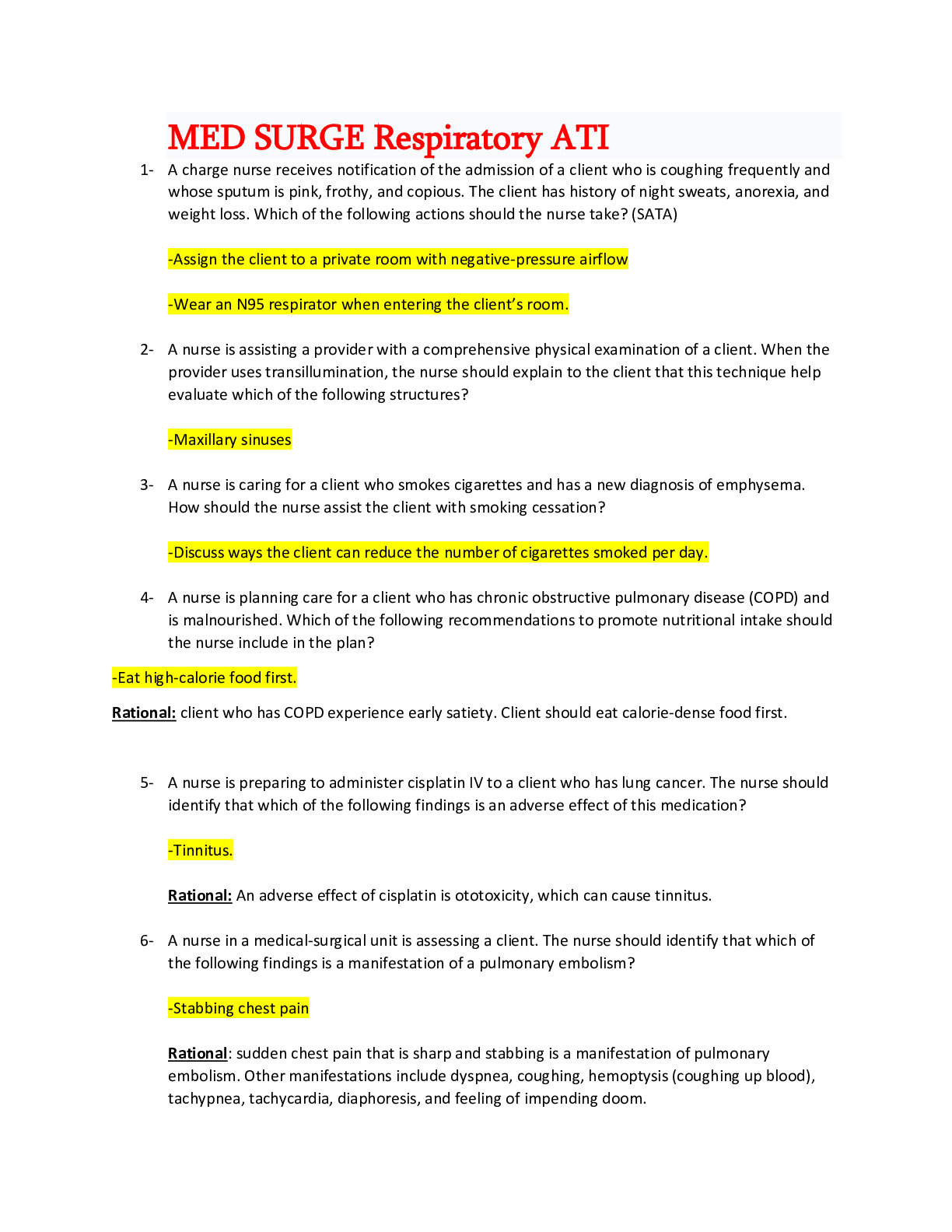
Buy this document to get the full access instantly
Instant Download Access after purchase
Buy NowInstant download
We Accept:

Reviews( 0 )
$25.00
Can't find what you want? Try our AI powered Search
Document information
Connected school, study & course
About the document
Uploaded On
Mar 04, 2021
Number of pages
31
Written in
Additional information
This document has been written for:
Uploaded
Mar 04, 2021
Downloads
0
Views
61






.png)

